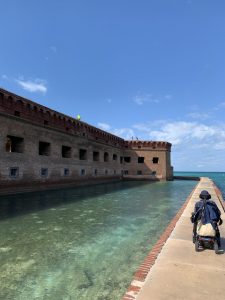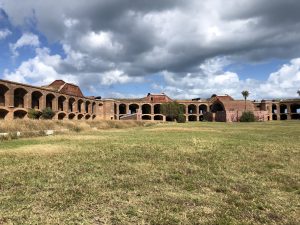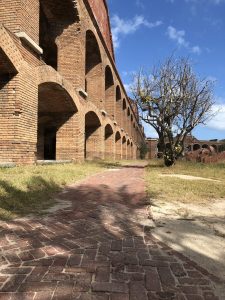When you think of the Americans with Disabilities Act (ADA), you may think – as I did – that buildings past a certain age are exempt from the ADA’s accessibility requirements. And when you hear someone say that, it is probably easy to accept without hesitation. After all, old buildings are relics of our cultural heritage; they are physical embodiments of history.
As a person with a disability, I also passively accepted this as truth, and even though it meant I would be excluded from experiencing history in the same way non-disabled people do, I honestly believed this was fair and reasonable on my part. For one, I can always read history in books, and another, I can always glimpse these buildings from the outside, then flip through an album or coffee table book of photographs that reveals the insides of these buildings to me. And frankly, how selfish would I be, to insist on degrading a historic building for my personal benefit, when I can easily experience the building’s legacy secondhand?
What The ADA Says
The ADA is actually more nuanced in its approach to historic buildings. First, not all buildings past a certain age are automatically considered “historic” in the eyes of the ADA. Historic buildings must be registered at the federal, state, or local level to qualify as historic landmarks. If they are not registered, they must follow all legal requirements outlined in the ADA. If a building is a registered historic landmark, it must still comply with the ADA unless it is determined that providing access “threatens or destroys the historic significance” of the building. And even in this instance, alternative methods of access must be provided, including:
- An accessible route from one site access point (e.g., a parking lot) to the accessible entry of the building
- An accessible building entry. If necessary, the ramp may be steeper than standard requirements. The accessible entrance can also be different than the main public entry, but it must be unlocked and have clear signage.
- At least one accessible toilet, which can be unisex
- Accessible routes to all public spaces on the level of the accessible entrance
- All displays and written information must be viewable by a seated person.
A Matter Of Priorities
A recent vacation to Key West, Florida sparked my interest in this question of accessibility in historic buildings. As you can imagine, an island community dating back to the 19th century had no shortage of old homes and buildings, many of which were extremely beautiful with their expansive columned verandas, painted shutters lining each window, wide front yards where coconut palms and banyan trees provided shade and seclusion. Wandering the streets and neighborhoods, I felt transported to the island’s rich past. For me this was, at first glance, preservation of history at its finest. Like entering a national park and feeling that sense of a place untouched by time.
But as the week wore on, the difficulty I encountered taking in the history of the place while those around me were free to experience all the island had to offer (within their relative constraints of time and money), I began to wonder if the inaccessibility was truly a consequence of preserving history, or of misplaced priorities and a plain lack of creativity.
In one example, my fiancé and I toured a series of art galleries. One of these galleries featured a lot of quirky art pieces of pets and animals, a dominant theme of art in our home, so naturally we wanted to go in and shop. Unfortunately, this art gallery had several steps at the front and no accessible alternative. The gallery owner excused the lack of access citing the age of the building and explaining that since he was not the building owner, there was nothing he could do. Meanwhile, there was another art gallery located in an old church across the street. The church preceded the first gallery’s building by several decades, but it had an accessible entrance.
On other shopping excursions, we found stores and restaurants with 3-4 inch thresholds at their entrances that effectively rendered them inaccessible. These establishments could have easily become accessible with the addition of a portable ramp purchased from a medical supply or hardware store. In none of these instances did the inaccessibility serve the historical significance of the buildings.
Does Access Really Ruin History?
The experience that stands out most to me was in arranging a day trip to Dry Tortugas National Park, a collection of seven small islands spread across 100 square miles of ocean and located nearly 70 miles west of Key West. This wholly unique park boasts a number of attractions including snorkeling, diving, boating, swimming, and birdwatching, but probably the most distinct feature is the Civil War-era Fort Jefferson, a massive, six-sided fortress composed of over 16 million bricks and spanning 16 acres. When inquiring about the accessibility of the fort over the phone, I recall being told the entire first level of the fort was accessible but that there was not an elevator to access the upper levels because that would have “obviously ruined the historical integrity of the fort.”
When I actually saw the fort in person, I thought back on that phone conversation and realized what a ridiculous notion it was, that the mere existence of an elevator somewhere on the premises would have ruined the place or somehow erased its history. And while I was expected to believe that inaccessibility was a necessary sacrifice for the higher purpose of historic preservation, I could see a retail gift shop and park ranger living quarters with electricity and window-mounted A/C units built directly into the brick fortress; I could see dilapidated structures being renovated, stairways under repair to ensure non-disabled visitors can access the upper floors. Is an accessibility feature really that different from these other structural modifications? Aren’t they all aimed at preserving a unique piece of American history for future generations of citizens to enjoy? Would accessibility really come at such a high cost?
Inclusion Is A Product Of Power
I don’t want to give you the impression that I had a terrible vacation or that disabled people should steer clear of Key West and Dry Tortugas. My trip had its ups and downs as any trip does. Although I wasn’t able to access the occasional art gallery, store, restaurant, the upstairs bedrooms of Ernest Hemingway’s house or the roof of Fort Jefferson, I still had a fantastic time, and I was able to experience the beauty and history of the islands from the parts I could access.
I do think, however, that when you hear the preservation of history used as a defense of inaccessibility, it is more likely an unwillingness on the part of the owner or whoever holds the power of decision-making over that space to make inclusion a priority. For me, a compassionate society is one where the value of buildings – historic and otherwise – arises from the diversity of people who are able to experience them and actively participate within their walls. We have the power to include everyone. Let’s do it!
What Do You Think?
Dialogue between differing perspectives can lead to a stronger, more inclusive society. So please share your thoughts on this issue! Are there instances where accessibility conflicts with historic preservation? Tell us in the comments or send us an email!
Eric Clow
OMOD Project Coordinator
Art Spark Texas




